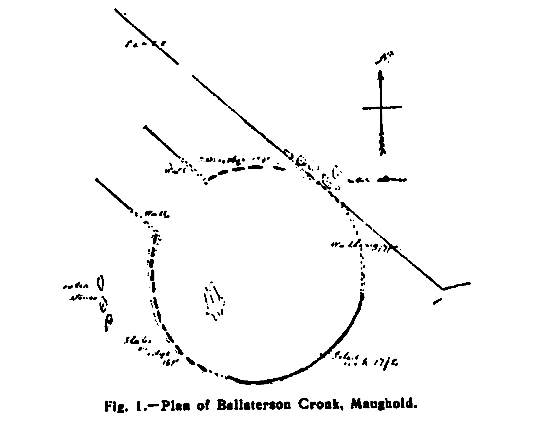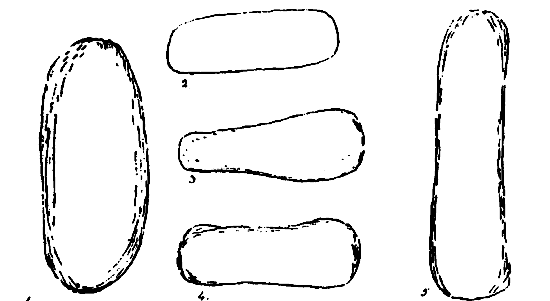
[From Proc IoMNHAS vol 1 #12]
By Rev. S. N. H:arrison.
( Read 25th February, 1909).
The barrow stands on the N.W. slope of the Cronk, with the entrance on the N.W. Before digging, the tops of the slabs on each side of the entrance and eleven of the standing stones in the outer semicircle were to be seen above the surface, together with the block standing within the barrow on the S. W. side, which measured 3 ft. 6 in. long by 2 ft diameter. Many loads of stones picked off the adjoining field had been carted on to the top of the barrow. This altered its appearance and added to the difficulty of tracing out the structure On removing these stones, it was seen that the surface of the barrow was concave in the centre.

The first cutting we made was along the S.W. side of the entrance. Inside the standing stone of outer semicircle was a slab 3 ft. long by 2 ft. 6 in. deep, on edge, leaning towards the N.E. Beyond this a rough bit of walling, about 4 ft. long and 3 ft. high, to where the inner circle commenced. From this point on we passed through loose stone roughly packed on top up to the standing block before referred to. Under these was dark soil, and lower down nearer the floor, ash, charcoal, and bone. Beyond the large block further S.E. was more ash and charcoal. After this we cut through the centre, where was more dark unctuous soil, with some charcoal and bone. On opening up the N.E. side of the entrance, there was but little difference from what was found in the S.W., except that the entrance slab was larger, 4 ft. long, and the stones beyond it were loosely packed, with some on edge. These were out of place. as though they had been disturbed, and were larger than others found within the Barrow.
Later on we traced out the inner circle. The portion on the S.W. was formed of twelve flat stones on edge from 1 ft. to 1¾ ft. long, closely packed, and kept in their place by small stones on the outside. Then followed a few loose stones up to the solid rock. Here the circle was continued for some 17 feet by using the edge of the rock, which had been cut down a foot deep along a natural joint. To this followed 17 more feet of walling from 1 ft. to 1½ ft. high ; then again slabs of stone as on the other side.
The floor of the barrow on the N. and W. was soil, with blocks of grit and sandstone ; the rest of the floor was rock. The quarry had been cut and cleaned out before forming the barrow. Cremation had taken place on the rock surface, as the ash charcoal and bone closely adhered to it, and the fire had reddened the rock on the N.E. side. So, too, on the earthen part of the floor, ash charcoal and bone rested, with thin slabs of stone over. Other layers of burnt bone and ash were found higher up in different places.

Fig. 2.—From Ballaterson Cronk, Maughold.—(1) Oblong hammer or pestle, worn at both ends, 7 to 8 in. ; each of the other stones is 6 in. long.
Quartz pebbles were scattered through the soil, and several pieces of granite, sandstone, and other rock were split by the fire. A lump of light-coloured clay and small piece of a red-coloured substance were found.
There was no trace of pottery, broken flint, or metal. The only implement was a stone hammer or pestle, 6 in. long, by about 1¾ in. diameter, rounded at both ends. There was also found a round smoothly-worn boulder of fine-grained granite, 2¾ in. in diameter by 7/8 in. thick, pierced by a hole countersunk, from ¾ in. to 1 in. diameter.
The diameter of the inner circle is 24 ft. from N.E. to S.W., and 22 ft. from NW. to S.E.
|
|
||
|
Any comments, errors or omissions
gratefully received The Editor |
||